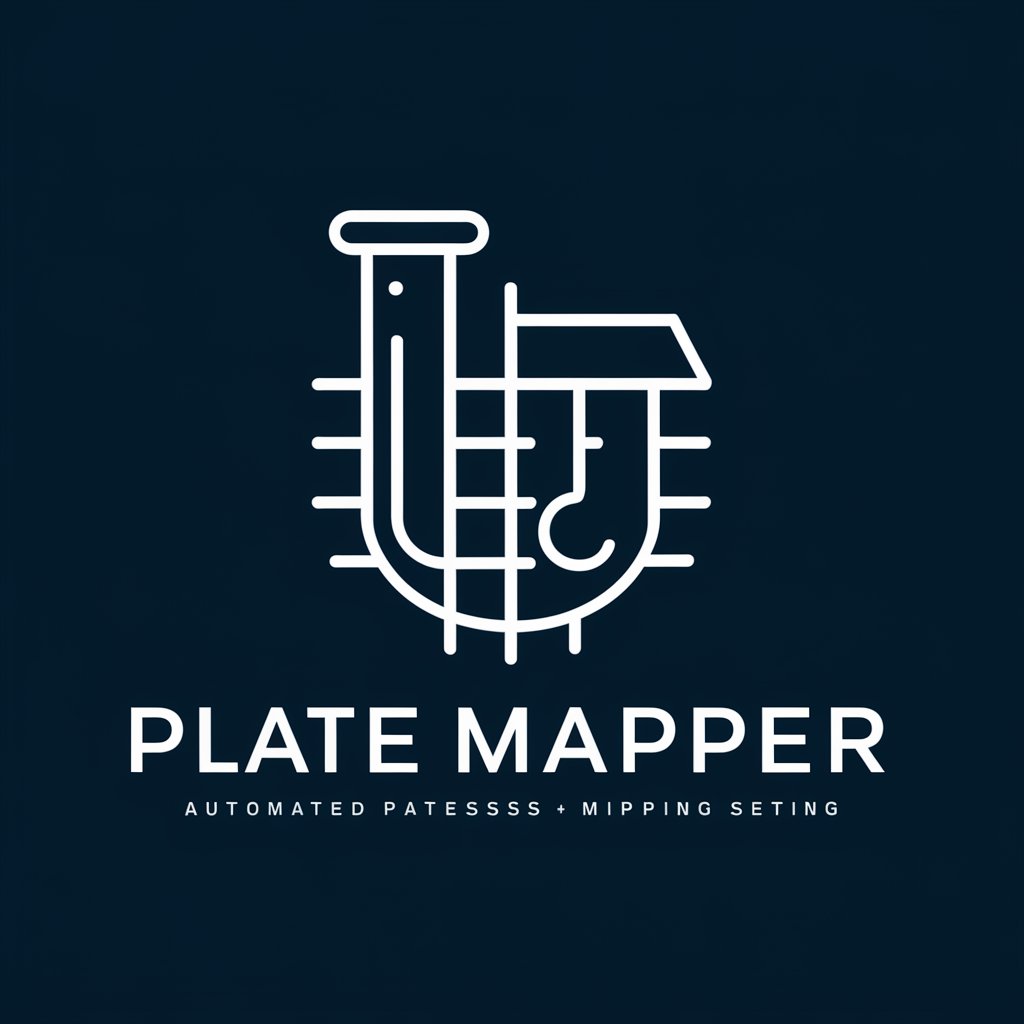
Plate Mapper - Automated Assay Plate Mapping

Welcome! Let's create your plate map for clinical trials efficiently.
Streamline Lab Workflows with AI
Please specify the assay type and number of standards for your plate map.
How many total subjects and samples per subject are you working with?
What is the sample identification/labeling system you will be using?
How many technical replicates are required for each sample?
Get Embed Code
Overview of Plate Mapper
Plate Mapper is designed to assist in organizing and managing immunoassays and multiplex assays for clinical trials. Its primary function is to automate the creation of plate maps, which are essential for accurate sample testing. Plate maps organize the layout of samples in a microplate, ensuring each sample is placed correctly according to the assay's requirements. This includes determining the arrangement of standards, quality controls (QCs), and subject samples across one or multiple plates. For example, in a clinical study involving blood samples from 50 patients, each needing duplicate tests, Plate Mapper would calculate the number of plates needed, generate the plate maps, and ensure samples are correctly positioned to prevent cross-contamination and maintain consistency across tests. Powered by ChatGPT-4o。

Key Functions of Plate Mapper
Calculating Total Specimens and Wells
Example
For a study with 100 subjects, each providing 2 samples and requiring duplicate assays, Plate Mapper calculates the total specimens as 200 (100 subjects * 2 samples each) and the total wells as 400 (200 specimens * 2 replicates each).
Scenario
Useful in large-scale clinical trials where managing the volume of samples manually is impractical.
Generating Plate Maps
Example
Plate Mapper can generate a plate map for an ELISA assay requiring standards at the beginning of the plate, followed by samples arranged according to subject ID. It ensures that all samples from the same subject are run on the same plate when possible.
Scenario
Ideal for assays requiring strict sample placement and replication standards to ensure the validity and repeatability of results.
Labeling and Tracking
Example
In a multiplex assay for a respiratory panel, Plate Mapper assigns unique identifiers for each sample and tracks their positions across multiple plates, documenting each sample’s journey from preparation to result.
Scenario
Crucial for studies where samples undergo multiple tests, making traceability and record-keeping paramount.
Target User Groups for Plate Mapper
Clinical Research Organizations (CROs)
CROs manage large volumes of clinical trials and need efficient, error-free ways to organize assay plates, making Plate Mapper an invaluable tool for enhancing their operational workflows.
Hospital Laboratories
Hospital labs conducting diagnostic tests and clinical research benefit from Plate Mapper’s ability to streamline assay setups, reduce human error, and maintain compliance with clinical standards.
Academic Research Institutions
Academic researchers conducting studies involving bioassays can use Plate Mapper to efficiently manage their sample testing, allowing more time to focus on analysis and discovery rather than logistical challenges.

How to Use Plate Mapper
Step 1
Access Plate Mapper by visiting yeschat.ai, where you can trial the tool for free without needing to log in or subscribe to ChatGPT Plus.
Step 2
Select the assay type relevant to your study, including the number of standards, quality controls, and technical replicates required.
Step 3
Input the total number of subjects and samples per subject, ensuring the sample identification system is clear and consistent.
Step 4
Review and confirm the automatically generated plate map that organizes samples efficiently, keeping samples from the same subject on the same plate when possible.
Step 5
Use the provided plate map to proceed with your assay in the laboratory, following the layout to minimize error and enhance reproducibility.
Try other advanced and practical GPTs
Plate Decoder
Unraveling the secrets of vanity plates with AI

Healthwise Plate
Tailored Nutrition with AI

Plate Perfectionist
Elevate Your Plate with AI

Wholesome Plate Guide
Nourish Smartly with AI

Paint my plate
Craft your culinary story with AI

Plate Planner
Crafting Your Perfect Menu, AI-Enhanced

Plate Processor
Culinary exploration at your fingertips.

Harvard Plate Nutrition Guide
AI-powered Nutritional Insights

Pick-A-Plate
Craft Your Perfect Meal with AI

Boiler Plate Coder
Optimize code with AI-powered precision.

Script Smith Bit Sized
Craft Winning Scripts, Powered by AI

64-bit Pixel maker
Craft Retro Art with AI Precision

Frequently Asked Questions About Plate Mapper
What is Plate Mapper primarily used for?
Plate Mapper is designed to create efficient plate maps for immunoassays and multiplex assays, primarily used in clinical trials. It helps in organizing standards, controls, and samples to optimize laboratory workflows.
Can Plate Mapper handle multiple assay types simultaneously?
Yes, Plate Mapper can be configured to handle different types of assays on the same platform, enabling users to switch between assay configurations as per their research needs.
How does Plate Mapper ensure the accuracy of the plate maps?
Plate Mapper uses a systematic algorithm to place samples in a way that reduces cross-contamination risks and ensures all samples from the same subject are analyzed on the same plate, enhancing consistency and reliability of results.
Is there a limit to the number of samples Plate Mapper can handle?
No, Plate Mapper is designed to scale up to accommodate a large number of samples and subjects as required by large-scale clinical trials, using multiple plates efficiently.
What support does Plate Mapper offer for troubleshooting?
Users can access detailed documentation and customer support for troubleshooting any issues with plate mapping, ensuring smooth operation and minimal downtime.